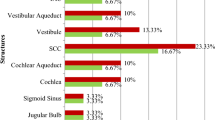Abstract
Purpose
There is no guideline or consensus on preoperative radiologic imaging modality despite the fact that it has a vital importance in appropriate candidacy selection of cochlear implantation. We aimed to find out the role of high-resolution computed tomography (HRCT) and magnetic resonance imaging (MRI) on surgical planning, intraoperative technique in cochlear implant candidates.
Methods
The clinical charts, imagings, and operative reports of patients who underwent cochlear implant surgery at a tertiary institution were retrospectively examined.
Results
611 patients (503 children and 108 adult) were enrolled into the study. We found 11 different pathologies in MRI which could not be seen in HRCT. However, we decided the side of surgery according to MRI in only three of them in which the pathology was cochlear nerve hypoplasia. Two patients with cochlear nerve hypoplasia were children with prelingual deafness and one was adult with perilingual deafness. Moreover, we changed the surgical planning of side according to both imaging modalities in nine patients. Seven of them were children and two were adult. One of these adults had cochlear anomaly, and another had bilateral temporal bone fracture.
Conclusions
We suggest both imaging modalities in pediatric candidates. However, in adults, we think that superiority of either imaging modalities is still contradictive. We had only three adult patients and the decision of the side of surgery was made according to MRI in one of them and to both imaging modalities in the other two adults.
Similar content being viewed by others
References
Bettman R, Beek E, Van Olphen A et al (2004) MRI versus CT in assessment of cochlear patency in cochlear implant candidates. Acta Otolaryngol 124:577–581
Bettman RHR, Graamans K, Van Olphen AF et al (2004) Semilongitudinal and axial CT planes in assessment of cochlear patency in cochlear implant candidates. Auris Nasus Larynx 31:119–124
Papsin BC (2005) Cochlear implantation in children with anomalous cochleovestibular anatomy. Laryngoscope 115:1–26
Tamplen M, Schwalje A, Lustig L et al (2016) Utility of preoperative computed tomography and magnetic resonance imaging in adult and pediatric cochlear implant candidates. Laryngoscope 126(6):1440–1445
Roberts DM, Bush ML, Jones RO (2014) Adult progressive sensorineural hearing loss: is preoperative imaging necessary before cochlear implantation? Otol Neurotol 35:241–245
Jiang ZY, Odiase E, Isaacson B et al (2014) Utility of MRIs in adult cochlear implant evaluations. Otol Neurotol 35:1533–1535
Schwartz SR, Chen BS (2014) The role of preoperative imaging for cochlear implantation in postlingually deafened adults. Otol Neurotol 35:1536–1540
Choi KJ, Kaylie DM (2017) What is the role of preoperative imaging for cochlear implants in adults with postlingual deafness? Laryngoscope 127(2):287–288
Sweeney AD, Carlson ML, Rivas A et al (2014) The limitations of computed tomography in adult cochlear implant evaluation. Am J Otolaryngol 35:396–399
Rosenburg RA, Cohen NL, Reede DL (1987) Radiographic imaging of cochlear implants. Ann OtoRhinol Laryngol 3:300–304
Jackler RK, Luxford WM, House WF (1987) Congenital malformation of the inner ear: classification based on embryogenesis. Laryngoscope 97:2–14
Heman-Ackah SE, Roland JT Jr, Haynes DS et al (2012) Pediatric cochlear implantation: candidacy evaluation, medical and surgical considerations, and expanding criteria. Otolaryngol Clin N Am 45(1):41–67
Seitz J, Held P, Waldeck A et al (2001) Value of high-resolution MR in patients scheduled for cochlear implantation. Acta Radiol 42:568–573
Ellul S, Shelton C, Davidson HC et al (2000) Preoperative cochlear implant imaging: is magnetic resonance imaging enough? Am J Otol 21:528–533
Parry DA, Booth T, Roland PS (2005) Advantages of magnetic resonance imaging over computed tomography in preoperative evaluation of pediatric cochlear implant candidates. Otol Neurotol 26:976–982
Trimble K, Blaser S, James AL et al (2007) Computed tomography and/or magnetic resonance imaging before pediatric cochlear implantation? Developing an investigative strategy. Otol Neurotol 28:317–324
Quaranta N, Bartoli R, Lopriore A et al (2005) Cochlear implantation in otosclerosis. Otol Neurotol 26:983–987
Steinback S, Brockmeier SJ, Kiefer J (2006) The large vestibular aqueduct—a case report and review of literature. Acta Otolaryngol 126:788–795
McClay JE, Booth TN, Parry DA et al (2008) Evaluation of pediatric sensorineural hearing loss with magnetic resonance imaging. Arch Otolaryngol Head Neck Surg 134(9):945–952
Tahir E, Bajin MD, Atay G et al (2017) Bony cochlear nerve canal and internal auditory canal measures predict cochlear nerve status. J Laryngol Otol 131(8):676–683
Author information
Authors and Affiliations
Corresponding author
Ethics declarations
Conflict of interest
None of the authors has any financial or other relationship that might lead to conflict of interests.
Ethical approval
All procedures performed in this study involving human participants were in accordance with the ethical standards of institutional research committee and with the 1964 Helsinki declaration and its later amendments or comparable ethical standards.
Additional information
Publisher’s Note
Springer Nature remains neutral with regard to jurisdictional claims in published maps and institutional affiliations.
Rights and permissions
About this article
Cite this article
Yigit, O., Kalaycik Ertugay, C., Yasak, A.G. et al. Which imaging modality in cochlear implant candidates?. Eur Arch Otorhinolaryngol 276, 1307–1311 (2019). https://doi.org/10.1007/s00405-019-05349-0
Received:
Accepted:
Published:
Issue Date:
DOI: https://doi.org/10.1007/s00405-019-05349-0




